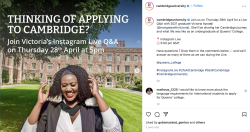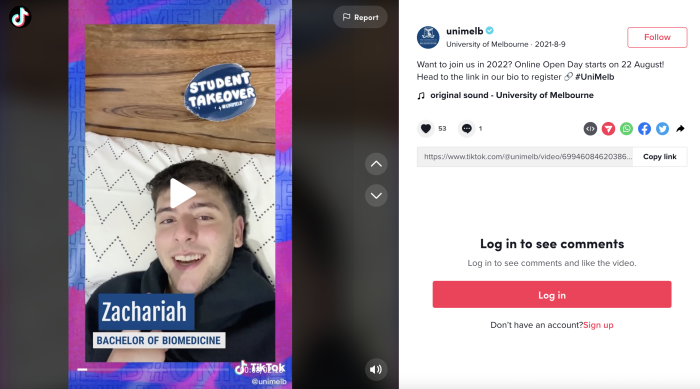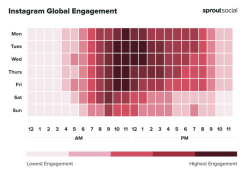Today, social media channels have blown up with unprecedented levels of content. Educational institutions around the world now rely on frequented platforms like Instagram, TikTok and Facebook to give prospective students a better idea of their brand and its offerings. With the competition for attention so great, it’s not enough to get your content out there. You need to focus on boosting the impressions, reactions and engagement that you’re looking for.
Your social media accounts are a chance to go beyond informational content and encourage prospects to make a meaningful connection with your school. From student videos and campus tours to opinion polls and Q&As, social media offers unique and interactive ways for prospects to get to know life at your school. If you’re looking to maximize your reach on social media, read on to learn how you can optimize these channels to engage prospective students.
Want to increase your school’s visibility on social media?
Discover how our strategies can amplify your reach and attract more students.

Engagement Begins With Content Creation
If you want to increase social media engagement across your school’s accounts, you need to start by creating content that prospects can engage with. Writing engaging content is about knowing your audience and what they want to see. Generally speaking, prospective students will be looking to a school’s social media pages for important updates and to get a better impression of what life on their campus is like.
Valentin Wimel, HEM’s Social Media Manager, shared some of the ways in which our social media team helps schools to ensure they are engaging prospects in the right conversations. According to Valentin, checking academic calendars is a great way to make sure we are sharing relevant content. When exams are coming up, consider sharing study tips or advice on managing the work-study balance to give prospects a useful guide to success at school. Likewise, interview tips or job advice is a good option to engage the career ambitions of those who are graduating.
Example: A tweet from the Academy of Learning Career College shared some practical tips for job applicants. This kind of content is well-suited to their target audience of career seekers looking for industry-relevant training.

Source: Twitter
Beyond sharing academic content, remember, social media platforms are a chance to get creative with your school’s unique selling points and develop a personalized voice for your brand. You want to encourage prospective students to connect with your school and its values as more than just a business. A good way to do this is by engaging in popular dialogues around current events. This could include content on school sporting events, social movements or academic discussions.
Example: Yale University created this Instagram post to celebrate International Women’s Day. The post gives users a chance to learn more about Yale’s history and its association with the movement as one of the first universities to admit women.

Source: Instagram
Posts such as these drive an emotional response by engaging the personal interests or concerns of prospects today. Users come to associate your school’s values and missions with their own. Applying trending hashtags to your posts (such as #InternationalWomensDay) will also increase the visibility of your brand and its content in online discussions.
Prioritize Visual Content
Once you have an idea of the kind of content you want to create, you can play around with the format. Social media platforms are well suited to visual content in the form of memes, videos and images. In particular, video content should also be a top priority for your school, as the amount of online videos people are watching has almost doubled since 2018. The best thing about video is that it can serve multiple purposes, from academic discussions to campus tours.
Example: A Facebook post from Duke University featured a video that gives users a sneak peek of one of its courses. The video features valuable information about the academic program in the form of student testimonials and an explanation of the program’s aims.

Source: Facebook
By bringing their academic experience to life, schools can engage prospects in a more authentic understanding of their institution. Not to mention, users are twice as likely to share video content with friends than any other type of content, giving your school a better chance of engaging new followers.
Make Use of Interactive Features
Each social media platform offers a number of popular features that encourage direct engagement from users. From Twitter polls and Q&As to Live Stories, these features give prospects new and exciting ways to participate in your school’s community.
For example, University College Dublin created a poll on LinkedIn that encourages users to actively engage with the school’s academic research. Users have the chance to express their own views while familiarizing themselves with hot topics at the university.

Source: LinkedIn
Another way to create an interactive experience on your accounts is to ask questions in a creative way to the audience. “We often create some posts to help potential students choose the right program (like quizzes or questions that could guide them), and ask alumni to share their advice with new students,” explains HEM’s Senior Social Media Specialist, Natalia Espinel-Quintero.
In the example below, Discovery Community College created an Instagram post asking its recent graduates to share their experiences with new students. This not only generates useful discussion in the comments section but also helps to engage both alumni and prospects in an active school community.

Example: Instagram
Live features take the level of engagement one step further by creating real-time interaction between your school and its audience. In particular, live video is a great way to take prospects on tours of your school, introduce them to members of the community and open a dialogue with them.
To maximize this effect, take the time to promote live videos across your social accounts first. That way, you not only attract more viewers but also build anticipation around the video as if it were a real-world event.
Example: Cambridge University created this Instagram post to advertise its upcoming Live Q&A. The post encourages viewers to come prepared with questions that they can ask during the live session.

Remember, effective social media engagement posts should lead prospects to take the next step in their journey with your school. Whether you’re aiming to give prospects a glimpse of life on campus, encourage them to sign up for more information or lead them to fill out an application, a specified call-to-action (CTA) is the best way to achieve this. If the goal is to boost engagement across your social media accounts, you can achieve this by encouraging users to drop a comment, vote on a poll or tune into live sessions.
Collaborate With Your Students on Social Media in Higher Education
Users are more likely to engage with content from those they can relate to – those who share their goals and interests. That being said, who would prospective students most likely relate best to? Your current students, of course.
Student-generated content is a great way to improve social media in higher education because it encourages people to post about your institution, leading to even greater exposure. One of the easiest ways to set this in motion is to create a hashtag for your school and encourage students to tag your accounts on their personal social media. Your school can then locate student content by searching for the hashtag, and re-post relevant content on its social media accounts.
For example, The University of Manchester created the hashtag #UoMGraduation to promote its graduation ceremony and showcase student experiences of the event. Retweeting those experiences is an easy way to generate more activity on your accounts.

Source: Twitter
Developing a strong student presence across your school’s social media accounts will also help to create a more authentic community experience. Users can see that your school has an active student body, one that they want to get involved in themselves. According to Valentin, student testimonials are a great way to share some real success stories with your audience and a simple way to motivate new applicants.
For example, Oxford College created the Instagram series “Happy Students” to celebrate the successes of its student body. This is a chance to engage prospects with more personal accounts that inspire them to follow suit.

Source: Instagram
To take some of the work off, consider incorporating social media takeovers. These are a chance for students to take the stage on your social media accounts and boost your school’s online presence. Social media takeovers can be used to share the experiences of individual students, clubs, campus events and more. Each post can help to engage users in an authentic first-person narrative of life at your school. TikTok is particularly well-suited to student takeovers and a valuable platform for engaging Gen Z prospects.
For example, the TikTok below is led by a University of Melbourne student and takes users through a typical day on campus. After capturing interest with a quick virtual tour, the post encourages users to take the next step in registering for the university’s upcoming Open Day.

Source: TikTok
Posts like these help to boost your school’s social media accounts with unique and personalized content. Through compelling narratives, you can build your brand identity while giving prospective students the chance to make that initial connection with your school community.
Monitor Accounts for Comments and Feedback
Engagement doesn’t end with content creation. In fact, many schools make the mistake of posting content and leaving it at that. To boost your social media presence, you need to meet users halfway and take every opportunity to open a dialogue with them. Remember, communication is a two-way street, so take the time to listen and respond to your audiences.
When you post content on your social media accounts, monitor the comments and respond to them in a timely manner. Whether it’s a question from a prospect or a concern from a parent, by interacting with each comment, you nurture that organic engagement.
Direct responses also help users to feel that your school is invested in the comments and concerns of its student body. If they see that you’re listening, they’re more likely to engage.
Schedule Posts to Engage Prospects at the Right Time
Timing plays a key role in social media engagement. A good social media strategy for schools requires an understanding of user behaviour – and not just what they want to see but when they are most likely to see it. Take into consideration your target audience. How old are they? Are you trying to attract local or international applicants? By paying attention to factors like time zones and peak social media hours for different age groups, you can create a posting schedule that will deliver content to the right users at the right time.
As the data below shows, each audience and each platform are different.


Source: Sprout Social
Above all, consistency is key. While you don’t want to make the mistake of bombarding your followers with new content, frequent posting is an essential practice to keep social media accounts active and maintain a strong following. Nowadays, users see tons of content on their social media feeds. By making a regular appearance, you create more opportunities for people to notice your content and engage with it.
Developing a schedule for your social media accounts is a practical way to ensure consistency. To make this process even easier, take advantage of scheduling tools to plan and prep posts in advance. Marketing automation tools such as HubSpot or HootSuite allow you to schedule posts in bulk across platforms like Facebook, Twitter and Instagram. You can use one system to distribute content according to the best practices of each site. With these scheduling tools, your school can organize its social media campaigns and stay on track to better engagement across each account.
Track Engagement Across Your School’s Accounts
If you want to know how to promote a school on social media effectively, you need to know how your current efforts are performing. After all, social media engagement revolves around measurable interactions on a post or page, such as the likes, shares or comments it receives. So start by running a social media audit and tracking your school’s social performance across each account.
There are numerous tools your school can use to evaluate its social media campaigns. Social media platforms like Facebook have their own built-in analytics tools which offer insights into how your posts are performing. This allows you to measure your social media engagement in terms of likes, comments, reactions, shares, retweets, click-through rates and more.
You can also opt to go with a third-party tool that is designed specifically for social media management. If you already use HubSpot or HootSuite for social media scheduling, consider making full use of these tools by using them to monitor social performance as well. For example, HubSpot allows you to track engagement and compare results across social media channels.
When you can see what kind of content is generating high levels of engagement, you can adapt your social media strategy for the future. If you’re seeing low engagement, reconsider the kind of content you’re putting out.
For example, the University of Bristol created a series of tweets to promote their support for the new Climate Action campaign. The post on the right offers a link to a blog post and received only 3 Retweets and 10 Likes. On the other hand, the post on the left features a short video with strong graphics that resulted in much higher levels of engagement.


Source: Twitter
If you’re seeing that one form of content performs much better than the other, your social media strategy should reflect that moving forward.
Boost Your Posts With Paid Ads
In a context where social media are saturated with content from all over, paid advertising is an effective way to reach a target audience quickly. Boosting a blog, for example, increases the chances that it will be read and that the audience will leave comments. Boosting a post you create on Instagram or Facebook is a great way to reach a broader audience. When you boost a post on social media, you pay the platform to amplify your post so it shows up as a sponsored post on your audience’s feed.
You can choose whether your advertising goal is more profile visits, website traffic or messages. You can also choose which platforms to invest in depending on your target audience. If you’re trying to reach prospective university students, TikTok is where to place your ads. Parents, on the other hand, are most likely to engage with content on Facebook.
Ultimately, social media platforms have huge potential to pique the interest of prospective students and drive conversions. Once you focus on maximizing their features and delivering content that generates a reaction, your school will be on its way to building a more active and engaging social media presence.
Want to increase your school’s visibility on social media?
Discover how our strategies can amplify your reach and attract more students.







